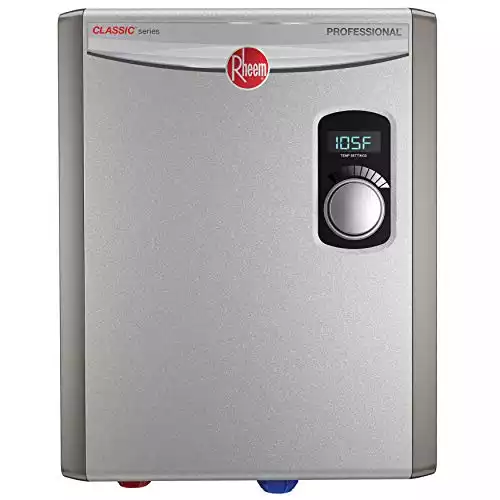The best water heater for radiant floor heat combines functionality, price, and performance.
But with so many options on the market, how do you choose?
Read on to learn all you need to know.
Our Top Picks at a Glance
1. Best Overall: Rinnai RU199iN
2. Runner-Up: Takagi T-H3-DV-N
3. Alternative: Rheem RTEX-18
Best Water Heater for Radiant Floor Heat
Let’s face it, there are hundreds of appliances choices out there, and the options seem endless in the age of the internet.
We know the struggle and set out to make a complete buyer’s guide to the best water heaters for radiant floor heat. There are many reasons this centuries-old system is resurfacing in modern homes across the country.
Before we begin, however, it’s important to know the best water heater for radiant floor heat. This ensures you get comfortable, consistent temperatures throughout the home.
Not all water heaters are up to the task. In this guide, we’ll explain how water heaters are used in radiant floor heating systems. We’ll also explore the criteria that water heaters used for radiant heating should meet.
We’ll also share our pick for the best water heater for radiant floor heat, plus two runners-up. Let’s start with how radiant heating works and why you might choose to install one of these systems.
Best Overall: Rinnai RU199iN
- Power Source: Natural Gas
- Heat Power and Performance: 199,000 BTUs and 11 GPM
- Water Heater Style: Tankless
- Cost: About $1,500
- Warranty: 10-year limited warranty on heat exchangers, 1-year on labor, 4-year on parts and components
The Rinnai RU199iN tankless water heater is a high-performance unit powered by natural gas. Because it’s tankless, it heats water to circulate under your flooring on demand.
It doesn’t waste energy preheating and reheating large amounts of water like a tank-style model. It can generate 11 gallons per minute (GPM) to ensure there’s plenty of hot water circulating in your radiant floor heating system at all times.
And once the water is warmed to the right temperature, it loses so little heat that the tankless water heater barely has to work to keep it hot.
That’s thanks to the 199,000 BTUs this model’s burner can handle while still maintaining a 93% to 96% energy efficiency rate.
As far as cost, it’s a little pricier than some other units on the market, but it’s well worth it at about $1,500.
The included 10-year warranty is one of the best you can get. Overall, it’s the top choice for the best water heater for radiant floor heating systems.
Runner-Up: Takagi T-H3-DV-N
- Power Source: Natural Gas
- Heat Power and Performance: 199,000 BTUs and 10 GPM
- Water Heater Style: Tankless
- Cost: About $670
- Warranty: 15-year limited warranty on heat exchangers, 5-year limited warranty on parts
While the Rinnai RU199iN tankless water heater is our pick for the best water heater for radiant floor heaters, the Takagi T-H3-DV-N is a close runner-up. It has a lot in common with the Rinnai model.
They’re both tankless water heaters with 199,000 BTUs that run off natural gas. It has a slightly lower flow rate of 10 gallons per minute (GPM), but that’s still more than enough to supply a radiant floor heating system with adequate hot water.
It has two heat exchanges to instantly heat water to the right temperature, and even with these features, it still has an energy efficiency rate of 93%. It also has an Energy Star certification.
Alternative: Rheem RTEX-18
- Power Source: Electric
- Heat Power and Performance: 18kW (18,000 Watts)
- Water Heater Style: Tankless
- Cost: About $375
- Warranty: 5-year warranty on heat exchanger, 1-year warranty on parts and components
For homeowners who prefer an electric water heater, the Rheem RTEX-18 is a great option for radiant floor heating systems.
It can supply the heating power needed to keep hot water circulating under your flooring, so the temperature inside is warm and pleasant.
There are a few special things about this unit as well. First, while its capacity isn’t as great as the Rinnai or Takagi units, it still delivers a good 6 gallons per minute (GPM) and operates at 18000 watts (18 kW).
It has a digital LED display for easy temperature control and use. Overall, it has a 99.8% energy efficiency rate—one of the best on the market.
Radiant Floor Heating Buyer’s Guide

Radiant floor heating isn’t new. Different versions of this concept have existed for centuries. In fact, we can trace the first version of radiant floor heating systems back to the Ottoman Empire in the 1400s.
There, raised floors that allowed hot air to circulate underneath were used to heat ancient Turkish baths. The second version of radiant floor heating uses electrical cables under the floor.
This version is generally used in smaller spaces because of the high electricity expense used in this capacity. The third (and most efficient, cost-effective) version is the radiant floor heat you’re probably most familiar with: Hydronic floor heating.
This is the same concept as traditional radiator heating, but applied differently. It’s the solution to heating your entire home.
This ensures you’ll never put your feet on a cold floor in the morning again. It’s an interesting concept, but before you buy a system, you should have a look at how a hydronic radiant floor heater works.
How Radiant Floor Heaters Work
Radiant floor heaters seem more complicated than they really are.
Here’s how the system works to keep your floors and entire home at a warm and comfortable temperature. Special, flexible PEX tubing is installed on top of the subfloor.

PEX tubing works especially well because it can bend as needed without joints in the tubing. The lengths of this tubing are laid about 9 inches apart and secured to the subfloor throughout the house (or wherever radiant floor heating is desired).
Both ends of the tubes are attached to a manifold. Concrete, dry-tamped mortar, or gypcrete are then installed on top of the subfloor, along with PEX tubing to seal the layer.
These three materials are used most often because they hold onto heat for longer periods. With the concrete, gypcrete, or mortar in place, ceramic tile is commonly used as the finished floor layer.
Ceramic tiles also hold onto heat efficiently. The PEX tubing underneath moves water from the manifold to a dedicated water heater (or boiler, in some cases).
The manifold evenly distributes water through the tubing to provide consistent heat throughout the rooms. A special circulating pump pulls water through the system and returns it to the water heater to be reheated.
As the water moves around the underfloor heating system, it doesn’t lose much heat—usually only about 10 degrees.
This means the water heater doesn’t have to work hard to keep the water hot enough to evenly heat the home. The heated water moves about under the floors and heats the concrete, gypcrete, or dry-tamped mortar layer.
That heat rises into the ceramic tile, and from there, it radiates out into the rooms of the house. That’s how radiant floor heating works and why a water heater is required in the system.
Benefits of Radiant Floor Heaters

Why would you choose radiant floor heating that requires a dedicated water heater instead of the common forced-air HVAC system?
There are plenty of good reasons. Here are some of the most pronounced benefits of radiant floor heating.
Ventless, Unobtrusive System
Heated air doesn’t need to travel through ducts to be delivered to the home with radiant floor heating systems. Heat rises and radiates directly from the floor.
This helps evenly and consistently warm the entire room. There are no obtrusive vents to break up the room’s layout and design and prevent desired furniture placement.
Cleaner, Healthier Air
Forced-air heating systems blow heated air through ducts. Allergens and particulate matter are blown and spread throughout the home with these systems, especially if the filters aren’t kept clean and changed regularly.
But radiant floor heating avoids this forced circulation of air entirely and heats the room without spreading allergens, dust, and particles around the home.
No Cold Spots

Radiant floor heating is even and consistent. The heated water running through tubes under the flooring radiates heat upward, so it dissipates into the entire room.
There are no cold spots, and even furniture can pick up the radiating warmth to ensure every part of the room is comfortable and warm.
Most Energy-Efficient Heating
A radiant floor heating system is one of the most energy-efficient options you can use. They’re anywhere from 10% to 30% more energy-efficient than a standard forced-air HVAC system.
This is because water, the primary element in the radiant heating system, is very efficient at retaining heat. It’s much more efficient than air.
The only energy required by the system is to keep circulating water at the right temperature using a water heater.
Water loses about 10 degrees in temperature as it circulates, so the water heater just has to raise the temperature a little each time it circulates through. This results in energy savings of up to 30%.
Choosing the Best Water Heater for Radiant Floor Heater Systems

Now that you know how radiant floor heaters work and the benefits of using a system like this, let’s look at the criteria your water heater should meet to make radiant floor heating possible.
The water heater is arguably the most crucial component of a radiant floor heating system. It’s the appliance that keeps the circulating water at the right temperature to heat the home.
Choosing the best water heater for radiant floor heating systems is absolutely essential. Here are a few criteria your water heater should meet to be used in a radiant floor heating system.
Power Source

Natural gas and electric water heaters are common for household use. You can choose either fuel type for radiant flooring systems, but natural gas water heaters are usually recommended.
You’ll find our recommendations for the best gas water heaters here. We’ll share the best electric water heater and gas water heater options for radiant flooring in the next section.
Heat Power and Performance

Choosing the best water heater for radiant floor heating systems means choosing one that delivers plenty of heat.
Heat power from gas water heaters is measured in BTUs, while heat power from electric water heaters is measured in kilowatts (kW), made up of 1,000 Watts.
The higher the BTUs, or kWs, the more heating power a water heater has. Choose the one with the highest heating power for the best water heater.
Water Heater Style

The style of the water heater you choose is also important. Tank and tankless models are available, but many opt for tankless-style water heaters (also called on-demand water heaters) for this purpose.
Tankless water heaters expose in-flowing water to powerful heaters inside, instantly heating the water to the right temperature.
Tankless styles don’t need to keep large amounts of water at a set temperature because of the heated water on demand.
This creates additional energy savings. Tank-style water heaters hold large amounts of water inside the tank, preheat it to the right temperature, and allow the water to flow out on demand.
When some of the water from the tank is used, more flows in to refill the tank, and it is again heated to the correct temperature. Tank-style models will work for radiant floor heating.
But they use more energy to keep the water at the correct temperature. Look for a tankless model to increase your radiant floor heating energy efficiency.
Cost

Another factor to consider when shopping for the best water heater for radiant floor heating systems is the cost.
Overall, radiant floor heating systems will cost anywhere from $6,000 to $14,000 to install, though your cost will vary based on square footage.
The water heater cost is only a small fraction of that cost, at about $300 to $1,600, depending on the style (tank or tankless), power source (natural gas or electric), and model you choose.
Tankless styles are generally a little more expensive, but they offer more energy efficiency and lower running costs. Water heaters are much less expensive than boilers, which are sometimes used for radiant floor heaters. Boilers cost upwards of $6,000.
Warranty

All water heaters will come with some type of warranty from the manufacturer. Pay close attention to the terms outlined within these warranties to pick the best water heater for radiant floor heaters.
In general, you’ll find water heater warranties range anywhere from 6-year to lifetime warranties. You’ll also find that some warranties cover the appliance overall, parts and components, labor, heating elements, or all of the above.
Lifetime warranties typically guarantee free replacements for a water heater for the homeowner’s lifetime, not the original appliance’s lifetime function.
Look for the longest and most inclusive (parts, labor, etc.) warranty available to ensure your water heater will be covered for many years.




